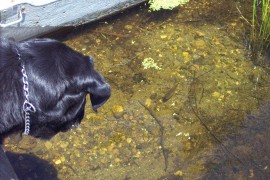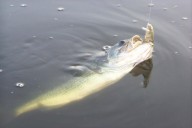Life at the Lake
a diary of living at a small lowland lakeWHAT IT'S LIKE

Early moonrise over Lake Ketchum
|
Archive Search |
| Links |
|
and s-integrator |
FISH-WATCHING DOG

Biff, fascinated with a bluegill guarding its nest
312
I cant' take my boat out to fish, or whatever, because a pair of bluegill fish have taken shelter under its stern and have built a redd, or nest, just out from where I'd launch it.
That's okay, for I generally fish off my dock, whether with bait or fly. So I am only slightly handicapped in my leisure-time pursuits. Meanwhile, Biff (my male Black Lab) is eternally fascinated with the male fish, whose job it is to guard the nest until the eggs hatch out, and maybe a little further.

See the telltale blue spot just behind his eye and on the gillcovers?
I admit to pointing the fish out to him last year, and again this year, so I am largely responsible for exploiting this characteristic, which is inherent in the breed, especially with males. Biff's sister, Cate, is indifferent, though she likes to watch me play a fish off the dock.
Biff, though, if not restrained by a leash, will dive right in and insist on retrieving the fish, a trout, and generally does a good job of it, with his "soft mouth." But I generally don't let him because he occasionally bears down, and the fish arrives on the beach without so much as a wiggle left in him.
And this constitutes a big loss in the catch and release department.
- - Comments ()
...
MANY BASS, ONLY MUCH SMALLER

Mature large-mouth bass, soon to be released
311
The trout fly fishing at dusk dropped off suddenly and left me standing there, rod in hand, disappointed. Only a few feeding rises sprinkled the near lake and they were of small fish, no doubt spinyrays from last year.
Then, Saturday, I stood gazing into the water off my dock when there was a small stirring motion on the surface, as if small raindrops were falling. But the rest of the lake showed no such behavior. Then I looked a few inches beneath the surface and was astonished at what was gong on there.
Tens of thousands of fish less than an inch in length were schooling, much like pictures I'd seen from skindivers in the coral shoals of the South Pacific.
They were dense and wiggly, behaving almost as though a single body, moving up and down in the water column and off in one direction or another. Of ten they came right below the surface, and that is when the rainfall disturbance took place.
Now having seen the phenomenon, I would see it repeatedly; I could not take my eyes off of it.
"This year's largemouth bass have come out of the gravels," I told myself. But I wasn't sure. I needed specific evidence. (All amateur biologists tell themselves this.)
So I went for an old aquarium net I'd found on the beach of the Stilly and plunged it into the herd of fry. Missed. Missed again and again. Then, on the fourth try, I nailed about a dozen of the little critters.
Silvery on the bottom, dark on the top, and with that characteristic dark band that marks the largemouth bass, whether fry or adult. No doubt about it, I decided, but looked at them through a magnifier, just to make sure.
The their emergence explained why the medium-sized rainbow trout had stopped going after the midge hatch at dusk: they were gorging on the bass fry, a new treat. And of course they were still feeding steadily, daily, on the snails to be found on the shallow bottom.
- - Comments ()
...